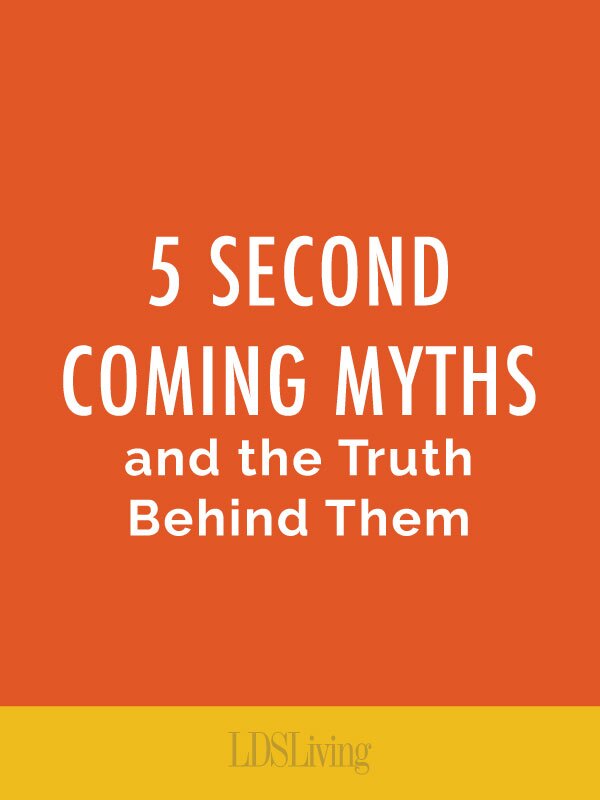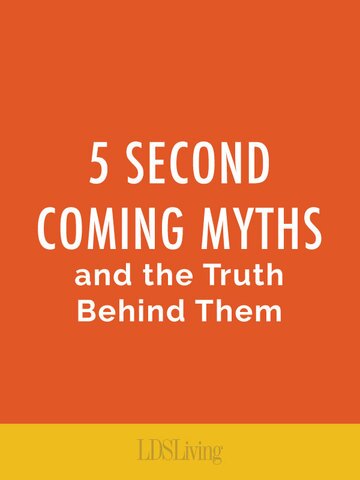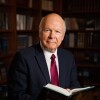
In working as a religious educator for almost four decades, I have been delighted to witness a significant rise in what might be called scriptural literacy or gospel scholarship among the young people of the Church. This is a tribute to devoted mothers and fathers, advisers and teachers, seminary and institute instructors. Our members are simply more capable and adept at utilizing the standard works in finding answers to their questions, seeking divine guidance, and explaining or defending the teachings of the restored gospel to those not of our faith.
And yet, there are certain misleading concepts, unsupportable ideas—myths—that persist among our members. Recently I wrote of five myths about the Millennium. Let me now suggest some mistaken notions I have encountered about the Second Coming of Jesus Christ.
Myth #1: Every person on earth will have heard the message of the restored gospel before the Lord returns in glory.
I suppose this idea has spread because of the Savior’s declaration on the Mount of Olives: “And again, this Gospel of the Kingdom shall be preached in all the world, for a witness unto all nations, and then shall the end come, or the destruction of the wicked” (Joseph Smith-Matthew 1:31).
Elsewhere we read that “the sound must go forth from this place into all the world, and unto the uttermost parts of the earth—the gospel must be preached unto every creature, with signs following them that believe” (D&C 58:64).
Yes, every man and woman who comes to planet earth will have an opportunity to hear and receive the fullness of the gospel, in his or her own tongue (D&C 90:11). But we all know that many of our Father’s children do not have that opportunity in this life; hence the powerful and expansive work of preaching the gospel that is going forward beyond the veil of death in the spirit world (D&C 138).
In addition, the work of gathering—which is really missionary work, the process by which the people of the earth are gathered to Christ, his gospel, his doctrine, his Church, and to the congregations of the faithful (see 1 Nephi 15:13-15; 2 Nephi 6:10-11; 9:1-2; 10:7-8)— will go forward in the great Millennium, after his coming in glory. This gathering will be of such a magnitude as to cause all previous gatherings to almost fade into insignificance (see Jeremiah 16:14-17; 1 Nephi 22:24-25; 2 Nephi 9:2; 30:6-18; 3 Nephi 21:25-26). All will hear, to be sure, but not necessarily before the Master returns.
Myth #2: Before Christ returns in glory, the faithful members of the Church will be asked to move to Missouri, to the Center Stake of Zion.
For many years, persons who joined The Church of Jesus Christ of Latter-day Saints were expected to gather to Zion, to the headquarters of the Church—to Kirtland, Independence, Nauvoo, and the Great Basin. “Zion shall not be moved out of her place, notwithstanding her children are scattered,” the Lord said in 1833. That is, the Center Stake of Zion is located in Independence, Missouri, and that will not change.
However, Independence is not the only place Saints gather today or will gather in the future. “And behold, there is none other place appointed than that which I have appointed. . . for the work of the gathering of my saints—until the day cometh when there is found no more room for them; and then I have other places which I will appoint unto them, and they shall be called stakes, for the curtains or the strength of Zion” (D&C 101:17, 20-21; emphasis added).
All of the people of the Church cannot, to use Isaiah’s metaphor, move to the center of the tent of Zion; we have been instructed to “Enlarge the place of thy tent, and let them stretch forth the curtains of thy habitations; . . . lengthen thy cords and strengthen thy stakes” (3 Nephi 22:2).
In a future day, Independence and its surrounding areas will play a very significant role in the unfolding story of the Restoration, and individuals will be called and assigned by those in authority to work there. But the call to relocate to Missouri is not now, and will not be in the future, a charge to the Church membership as a whole.
True Saints do not run before they are sent, nor do they run before their leaders. As the Church has grown and expanded throughout the earth, the Brethren have instructed members of the Church to remain in the wards and branches in the towns and cities where they are baptized, to help to establish Zion there. In our day, every ward and branch, every stake and district, is the gathering place for its members.
Myth #3: The faithful Saints will be spared the trials, calamities, and changes that will come upon the world before the Savior comes.
While we must be positive and assume a wholesome and affirmative stance toward national and world conditions, in the end, what will be will be. The prophetic picture does not suggest that the world will get better, that everyone will suddenly (or even gradually) begin to keep the commandments and incorporate the teachings of Jesus into their lives.
All who stay on the gospel path will know the protection that comes only through faithfulness. The Prophet Joseph explained, however, that “it is a false idea that the Saints will escape all the judgments, whilst the wicked suffer; for all flesh is subject to suffer. . . . [Y]et many of the righteous shall fall a prey to disease, to pestilence, etc. . . . So that it is an unhallowed principle to say that such and such have transgressed because they have been preyed upon by disease or death, for all flesh is subject to death; and the Savior has said, ‘Judge not, lest ye be judged’” (History of the Church 4:11).
Myth #4: If we will live the gospel and purify our lives, we can hasten the Lord’s coming and help to usher in the glorious Millennium.
To be sure, Latter-day Saints far and wide can strive to create a spiritual environment in their own homes that is, as President David O. McKay used to describe it, a little bit of heaven on earth.
We can seek to establish and move forward the cause of Zion (D&C 6:6; 11:6; 14:6; 21:7). We can assist Zion to acquire its destined beauty and holiness (D&C 82:14). We can help to “redeem” Zion (D&C 100:13; 103:15) through living the law of the celestial kingdom (D&C 105:5, 32). In summary, we can hasten the establishment of the earthly City of Holiness (Moses 7:19, 62), the place of the pure in heart (D&C 97:21), no matter where we live.
But the day of the Second Coming of the Lord in glory is fixed, set, established, just as was the day of his first coming. Isaiah or Nephi or Abinadi did not call upon the people to repent so that the Holy One of Israel could come into mortality sooner. The Second Coming may not be postponed by unbridled wickedness nor hurried by consummate righteousness.
“The God of heaven has ordained that day,” President Gordon B. Hinckley stated. “The prophets of all dispensations have spoken of it. We know not when it will come, but its dawning is certain.” (Teachings of Gordon B. Hinckley, 1997, 577; emphasis added; see also Bruce R. McConkie, The Millennial Messiah, 1982, 26-27, 405.)
Myth #5: No one, not even the most faithful Saints of God, will know the time of the Savior’s return. He will come “as a thief in the night.”
Well, that’s certainly what the scriptures say (Joseph Smith-Matthew 1:40; D&C 39:21). We are told in the Bible that the Lord Jesus Christ will come “as a thief in the night” (1 Thessalonians 5:2; 2 Peter 3:10; Revelation 3:3). That is, he will come suddenly, unexpectedly, when the generality of humankind is unprepared, unready, not watching.
This need not, however, be the case with the Lord’s Saints. The Master clarified: “And again, verily I say unto you, the coming of the Lord draweth nigh, and it overtaketh the world as a thief in the night—therefore, gird up your loins, that you may be the children of light, and that day shall not overtake you as a thief” (D&C 106:4-5; emphasis added).
We may not know the specific hour or the day when our Lord will come, but we can know the season. In distinguishing between the children of darkness and the children of light, the apostle Paul used the analogy of a very pregnant woman (1 Thessalonians 5:1-6).
If Paul will excuse my wresting of his analogy, try to imagine a conversation with a woman who is horribly uncomfortable and extremely impatient for the delivery. “So, you’re going to have a baby, are you?” a rather insensitive man asks. “Yes, that seems to be the case,” she answers as she rolls her eyes. He asks: “And so when is the baby coming?” Stretch your imagination and try to picture her answering as follows: “Oh, I don’t know. I suppose no one really knows. It may be in a year or so, perhaps in a couple of years. I really cannot tell for sure.” Ridiculous, isn’t it? Her response would more likely be something like this: “Listen to me: I don’t know the exact minute when the baby will come, but this much I can say—It will be soon! It must be soon! The signs in my body tell me that it is any time now.”
Those who “are wise and have received the truth, and have taken the Holy Spirit for their guide, and have not been deceived” (D&C 45:57) will sense and recognize the nearness of the return of the King of kings and Lord of lords. The spiritually sensitive members of the Lord’s Church, the body of Christ, will be in a readiness to read the signs and thus be prepared, even enthusiastic for that day that has been described as both great and dreadful.
It is my hope that we will search the scriptures and attend carefully to the words of the Lord’s anointed servants. Only in this way will we avoid confusion, error, and distraction. Indeed, may we read the signs of the times by the lamp of humility and as guided by the Light of the world and those seers and revelators who represent him.
Learn more in Robert L. Millet's book, Living in the Millennium. Available in hardcover or ebook at deseretbook.com.
More about the book:
The Savior taught through the Prophet Joseph Smith that the time will come when "he that liveth in righteousness shall be changed in the twinkling of an eye, and the earth shall pass away so as by fire" (Doctrine and Covenants 43:32).
What do we know about that day when Jesus Christ will come in glory to cleanse the earth? And what will life be like after He comes to reign?
In Living in the Millennium, the companion volume to Living in the Eleventh Hour, author Robert L. Millet shows us what life will be like during and after the Millennium. Relying on the words of prophets, he shares what has been revealed about Christ's preliminary appearances, His return in majesty and power, and His millennial reign—a thousand years of goodness and peace.



